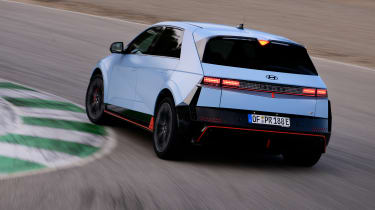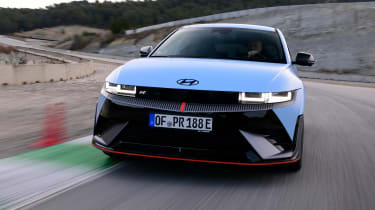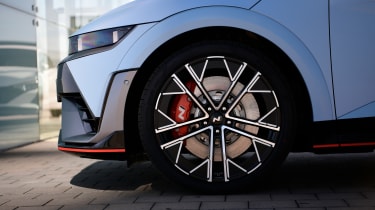Hyundai Ioniq 5 N 2024 review – the most engaging EV yet
Hyundai has used every trick in the book – and written a few new ones – to make the Ioniq 5 N fun to drive. The results are truly impressive
Following an early test of the Hyundai Ioniq 5 N in South Korea, we’ve now been able to drive the car on European roads – and on the track – in Spain. The result is really quite intriguing: here is a genuinely enjoyable, engaging performance car. In many ways it makes a virtue of its all-electric powertrain; in others it deliberately mimics the behaviour of traditional combustion-engined performance cars. More so than most, it’s a car that needs time to fully get to know: after a full day of driving the car over a good few miles on all kinds of roads, and a surprisingly long session on a circuit, it still feels like we’re at the very beginning of understanding its strengths, weaknesses and the full depth of its abilities. But one thing is clear, Hyundai has built a genuinely engaging all-electric driver’s car.
The Ioniq 5 N is, of course, based on the regular Hyundai Ioniq 5 electric family hatchback/crossover. It’s had a very thorough overhaul, however, with fundamental engineering changes to the chassis. The body-in-white gains 42 additional weld points and extra bonding adhesive to increase rigidity, alongside stiffened front and rear subframes. The steering rack has also been reinforced, with stronger mounting points for the N-specific battery and motor setup.
More reviews
> 1093bhp Porsche Taycan Turbo GT targets the Tesla Model S Plaid
Two motors – one at each axle – generate a combined 601bhp (an extra 40bhp is available for ten second bursts via a boost button on the steering wheel, with the moderately toe-curling name N Grin Boost). The rear motor uses an electronically controlled differential to distribute torque between the rear wheels, and the system is fed by an 84kWh battery with its own radiator and cooling circuit to provide repeatable performance on track. Very difficult to achieve in an energy-hungry 2.2-ton EV, but Hyundai promises to have cracked it, thanks in part to the platform’s 800v architecture which allows for rapid charging rates (up to 350kW) and comprehensive heat management.
The fact that track capability is on the cards at all says a lot about the depth of engineering Hyundai has thrown at the Ioniq 5 N. It has also thrown an awful lot of configurability and driving modes into the mix, controlled from shortcut buttons on the wheel and deeper menus within the dash-mounted touchscreen. From N Active Sound, N e-Shift, N Battery Preconditioning, N Torque Distribution, N Pedal, N Drift Optimizer to N Race, the number of adjustable parameters is dizzying.
Leaving the configurability alone and slipping into Barcelona traffic in the car’s default drive mode, it’s an entirely easy and straightforward car to operate. Interior fit and finish is impressive, as is refinement from road and wind noise at speed. It feels much like most mainstream EVs, only with rather nicer steering: progressive, and relatively feelsome (with three configurable levels of weighting, naturally). The ride is a little firm as speed builds out of town and onto rural roads, with the spring rates feeling rather tough, no doubt in deference to the 2.2-ton kerb weight. In the firmest of the three damper modes, it can feel quite jarring and the softest mode is the best fit for most road scenarios. But – and here’s the first sense that this is no ordinary family EV – it controls its mass very well indeed. As we gradually up the pace, it begins to feel like a more traditional 4WD performance car: if you attack a corner, it swiftly settles, takes a set and arcs through the bend with a little bit of yaw. With the low centre of gravity, there’s no untidiness on corner exit and – unusually for an EV – you can start to get into something of a flow.
There’s ultimately only so much you can hide from the sheer mass at play, but Hyundai’s N engineers have hidden it pretty thoroughly. Most of the time, it feels like a car that weighs 400kg or so less than it really does. (Though it never feels like a small car: on these narrow, Catalan mountain roads, it always feels a bulky car dimensionally.)
The accelerator map is gentle and it accelerates smoothly, rather than savagely – unless you use the Grin Boost button, at which point it can exhibit ballistic straight-line pace should you wish.
The intrigue deepens when you begin to experiment with more of the settings within the N menus. Most notably, the option to simulate the sound and response of a petrol engine and a paddle-shift gearbox. In N e-shift Mode, the Ioniq 5 N can simulate an 8000rpm petrol engine connected to an eight-speed dual-clutch gearbox. The torque curve, rev limiter, shift response and engine braking have each been calibrated to mimic a petrol car, and the effect is actually very convincing. Though you’re never entirely fooled, it does feel uncannily realistic. And the point is not to fool the driver, or to be a gimmick, but to help the driver: feedback from many drivers who’ve spent time in EVs, particularly while driving enthusiastically, finds that many feel disoriented or occasionally nauseous without the normal bearing points of engine noise and gearchanges to orientate themselves while driving. Work your way through the sweep of artificial revs (even hitting a false limiter, should you wait too long to change up in manual mode) and performance builds in what feels like a more natural crescendo. On upshifts, the system temporarily backs off the power and on downshifts, it uses regenerative braking. You can downshift using ‘engine’ braking to tuck into corners just as you might in an i30 N.
Driven in this mode, the car is slower than it might otherwise be in terms of ultimate pace, but more engaging. It’s perhaps a shame that Hyundai got the tricky part – the calibration – right, but has made it sound so silly. The distorted synthesised engine note sounds like it’s been ripped from Gran Turismo 2 (though maybe that’s being unkind to the game.) The fake exhaust pops and crackles on the ‘overrun’ are a little cringeworthy too. There are three choices of sounds, one akin to a sort of rorty four-cylinder, one a little like a higher-revving engine, and one modelled on a jet engine (a jet engine that can be bounced off a rev limiter). But they work – they really do give you a sense of how fast the car is accelerating or decelerating, and it’s fascinating to hypothesise on how it may evolve the system further.
On the braking front, a brake-by-wire system continuously blends regenerative motor braking and the regular hydraulic brakes – even when the ABS is engaged on tarmac surfaces, retaining 0.2g of regenerative braking right at the point of lock up. Hyundai’s engineers say that no other EV on the market currently deploys motor braking to this extent, and that as a result the brakes last longer on track than those of an i30 N, despite the Ioniq’s much greater kerb weight.
There is also an N Pedal function, which uses aggressive regenerative braking to drive at speed without needing to touch the brake pedal. Senior Hyundai engineers say it is possible to drive around a circuit at a decent lick of pace without once touching the brake pedal. In this mode, it’s easier to mobilise the rear end when you back off the accelerator mid-corner. Its switch-like action is difficult to modulate smoothly as you get used to it, and it’s best experimented with on track rather than on the road, particularly as it can instigate lift-off oversteer.
The N Drift Optimizer, an oversteer mode that enables you to slide around at low speeds, is best used for shredding an expensive set of 21-inch Pirellis within a few corners, and it doesn’t actually make drifting very easy (or enjoyable, compared with a conventional car). We tried this function on a coned off area adjacent to the Castelloli circuit in the hills north of Barcelona.
On the circuit itself, the car acquits itself remarkably well. As on the road, it’s most engaging and less dizzying with the gearshifts and sounds switched on, and it’s far more agile than one might ever expect of such a heavy car. In some ways it’s reminiscent of cars such as the AMG GLA 45, although it’s a little less adjustable and you can feel the extra mass through some of the circuit’s quicker corners. Here’s the thing though: it made me smile, it made me giggle and I had a great time driving it. More so than I’d expected.
And without flattening the battery after a few laps. Although Hyundai had a mobile truck acting as a charging station into which cars were continually being plugged into to top up, engineers said that in most scenarios, a morning of 30-minute sessions on the circuit was only reducing the battery from around 100 per cent to 75 per cent. And that in many cases, the front brake discs were not getting hotter than 100 deg C.
On the road, official range should be around 280 miles, subject to final WLTP homologation. We used up around half the battery during a morning’s driving on a range of roads, from city centre streets to motorways to steep mountain passes and fast A- and B-roads. And it says something for the car’s bandwidth that we could lap a race track at speed, attempt drifting on a makeshift skid pan, make ourselves nauseous learning to use the launch control, and then whisper off to the airport in a quiet, comfortable, practical family EV that feels almost like an entirely different car.
The Ioniq 5 N does not feel especially remarkable on first acquaintance, but the more you dig into its layers, the more talented is the car that emerges. Longer exposure to the car on British roads may expose flaws (or further reinforce its strengths) but there’s little doubt that Hyundai has produced one of the most convincing electric performance cars yet.
Price and rivals
There’s no denying that £65,000 is a huge sum of money for a hot pseudo-crossover, but it’s hard to think of any sub-£100k EV that comes close to the Ioniq 5 N for its dynamic ability and sense of fun. You’ll need to look at the £79,200 Porsche Taycan to get anywhere close, but the base 402bhp rear-wheel drive version is significantly less powerful than the Hyundai and has more of a straight-laced feel.
Given the extensive engineering and software development work ingrained in the project, it's surprising that the Ioniq 5 N costs just £2355 more than the 577bhp Kia EV6 GT – a car that shares the same platform but is streets behind the Hyundai for involvement and depth of engineering. The same goes for the £67,540 Ford Mustang Mach-E GT, and any current Tesla.
Hyundai Ioniq 5 N specs
| Motors | 223bhp front, 378bhp rear |
| Power | 601bhp (641bhp overboost) |
| Torque | 546lb ft |
| Weight | 2235kg |
| 0-62mph | 3.4sec |
| Top speed | 161mph |
| Battery | 84kWh |
| Price | £65,000 |







